
Exploring the Historic Berytus Cardo & Decumanus Maximus
Discover the ancient Roman heritage of Beirut at the Berytus Cardo and Decumanus Maximus, where history and culture intertwine.
Step back in time at the Berytus Cardo and Decumanus Maximus in Beirut, where ancient Roman streets whisper stories of the past, offering a captivating glimpse into the city's rich history.
A brief summary to Berytus Cardo & Decumanus Maximus
- VGW3+2WM, Beirut, LB
- Visit website
Local tips
- Visit during the early morning or late afternoon for the best lighting and fewer crowds.
- Wear comfortable shoes as you will be walking on uneven cobblestones.
- Take a guided tour to gain deeper insights into the historical significance of the ruins.
- Don't forget to explore the nearby cafes for a taste of local Lebanese cuisine.
- Bring a camera to capture the stunning blend of ancient ruins and modern architecture.
Getting There
-
Car
Start from the center of Baabda. Head northwest on the main road towards the Beirut-Damascus highway (also known as the A1). Merge onto A1 and drive towards Beirut. After approximately 10 minutes, take the exit toward the city center. Continue straight until you reach the intersection with Omar Daouk Street. Turn right onto Omar Daouk Street, then take a left onto the street leading to the Berytus Cardo & Decumanus Maximus location, which should be marked as VGW3+2WM, Beirut. Parking may be available nearby, but be mindful of local parking regulations.
-
Public Transportation
From Baabda, head to the nearest bus stop where you can find local buses heading towards Beirut. Board a bus that goes to the Beirut city center (look for routes that say 'Downtown' or 'Beirut' on them). The fare for this trip is usually around 1,500 to 2,000 LBP. Once you arrive at the city center, disembark at the main square and ask for directions to VGW3+2WM, Beirut. It is a short walk from the main square to the Berytus Cardo & Decumanus Maximus.
-
Taxi or Ride-Hailing Service
If you prefer a more direct route, you can take a taxi or use a ride-hailing service like Careem or Uber. Simply provide the driver with the address VGW3+2WM, Beirut. The ride should take around 15-20 minutes depending on traffic, and the fare is typically between 10,000 to 15,000 LBP.
Discover more about Berytus Cardo & Decumanus Maximus
Iconic landmarks you can’t miss
Le Grand Théatre des Milles et Une Nuits
0.1 km
Discover the enchanting Le Grand Théâtre des Milles et Une Nuits, a historical landmark in Beirut, rich in culture and artistic performances.

Mausoleum of Rafic Hariri
0.2 km
Explore the Mausoleum of Rafic Hariri in Beirut, a stunning tribute to resilience and legacy in the heart of Lebanon's vibrant capital.
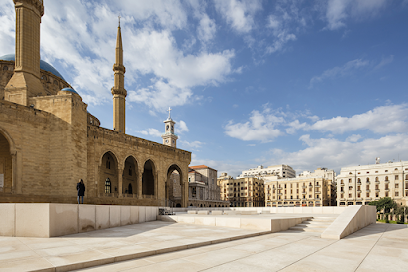
Saint George Greek Orthodox Cathedral Crypt Museum
0.2 km
Explore the rich history of Lebanon at the Saint George Greek Orthodox Cathedral Crypt Museum in Beirut, a hidden gem of archaeological wonders.

Al-Abed Clock Tower
0.2 km
Discover the Al-Abed Clock Tower in the heart of Beirut, a historical landmark blending rich heritage with vibrant city life.

Show Me Lebanon
0.3 km
Explore Beirut like a local with Show Me Lebanon - your gateway to personalized tours and authentic experiences in Lebanon's vibrant capital.

Place Amin El Hafez
0.3 km
Explore the rich heritage of Beirut at Place Amin El Hafez, a historic landmark that narrates the city's captivating story through stunning architecture and vibrant culture.

Tour Beirut's Walking Tour
0.3 km
Explore Beirut's rich history and vibrant culture through a captivating walking tour that unveils the city's hidden gems and iconic landmarks.

تمثال جبران خليل جبران
0.3 km
Explore the Jebran Khalil Jebran Monument in Beirut, a stunning tribute to a literary genius, surrounded by cultural richness and artistic beauty.

تمثال جبران خليل جبران
0.3 km
Explore the Jebran Khalil Jebran Monument in Beirut, a captivating tribute to the literary genius and a serene retreat in the heart of the city.

Hamidiye Clock Tower
0.3 km
Discover the historical charm of Hamidiye Clock Tower in Beirut, a beautiful landmark that blends rich heritage with vibrant city life.

St. Elie - Church
0.3 km
Discover the architectural beauty and spiritual significance of St. Elie Church in Beirut, a cultural landmark steeped in history.

Lebanon tours - City Sightseeing Beirut
0.4 km
Discover Beirut's rich history and vibrant culture with City Sightseeing Tours, the ultimate way to explore Lebanon's capital city.
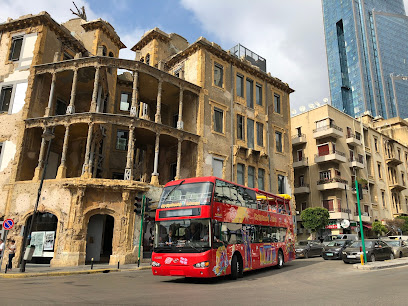
Beirut Souks
0.4 km
Discover Beirut Souks, a vibrant shopping paradise blending modernity with Lebanese tradition, offering a unique experience for every traveler.
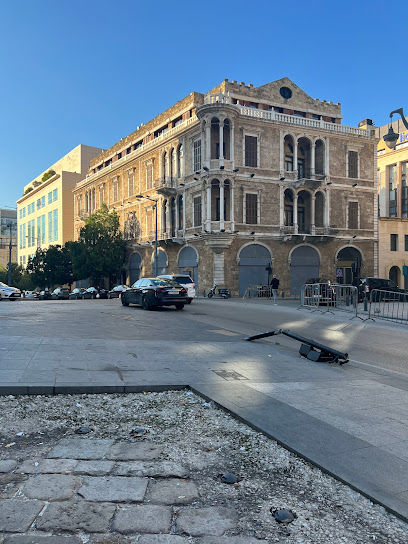
St. Maroun Maronite Catholic Church
0.5 km
Explore the stunning St. Maroun Maronite Catholic Church, an architectural gem in Beirut showcasing rich history and spiritual beauty.

Musée de la Préhistoire Libanaise
0.5 km
Uncover Lebanon's ancient history at Musée de la Préhistoire Libanaise, a must-visit archaeological museum showcasing rich prehistoric artifacts.
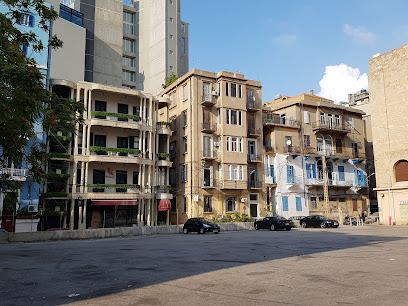
Unmissable attractions to see
Saint George Maronite Cathedral
0.0 km
Explore the exquisite Saint George Maronite Cathedral in Beirut, a stunning architectural gem steeped in rich history and vibrant culture.

Roman Forum of Beirut
0.1 km
Discover the Roman Forum of Beirut, a historic landmark that showcases Lebanon's rich cultural heritage and ancient architectural grandeur.

Mohammad Al Amin Mosque
0.1 km
Explore the breathtaking beauty of Mohammad Al Amin Mosque, a stunning architectural gem in the heart of Beirut, Lebanon.

Saint George Greek Orthodox Cathedral
0.1 km
Explore the architectural wonder of Saint George Greek Orthodox Cathedral, a serene and historic gem in the heart of Beirut, reflecting rich cultural heritage.

Downtown Tree
0.2 km
Experience the tranquility of Downtown Tree, an urban oasis in Beirut where nature meets the city's vibrant culture, perfect for relaxation and exploration.
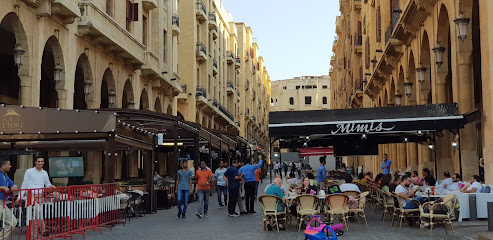
Place de l'Étoile
0.2 km
Experience the grandeur of Place de l'Étoile, home to the iconic Arc de Triomphe and a vibrant hub of Parisian culture.
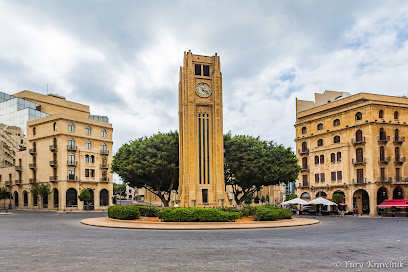
The Egg (The Dome) Beirut
0.2 km
Explore The Egg in Beirut, a masterpiece of architectural heritage symbolizing resilience and the vibrant history of Lebanon.

St. Elias Melkite Greek Catholic Cathedral
0.2 km
Experience the spiritual beauty and architectural grandeur of St. Elias Melkite Greek Catholic Cathedral in the heart of Beirut.

Martyrs' Square
0.3 km
Explore Martyrs' Square, a vibrant plaza in Beirut that symbolizes the city's history, resilience, and cultural richness.

Charles Debbas Park
0.3 km
Charles Debbas Park: A peaceful garden escape in the heart of Beirut, perfect for relaxation and family fun amidst nature's beauty.

Roman Bath Ruins
0.3 km
Explore the Roman Bath Ruins in Beirut, a captivating glimpse into ancient history with stunning architecture and rich cultural heritage.

Al-Omari Grand Mosque
0.3 km
Explore the Al-Omari Grand Mosque, a historical gem in Beirut, showcasing intricate architecture and a blend of cultures, perfect for every traveler.

Chc
0.3 km
Explore Chc, a vibrant tourist attraction in Beirut that showcases the city’s rich history and culture, perfect for an unforgettable travel experience.

Beirut Christmas Village
0.3 km
Discover the festive charm of Beirut Christmas Village, a magical holiday destination filled with lights, local crafts, and seasonal treats.

Samir Kassir square and statue
0.4 km
Experience the vibrant culture and rich history of Beirut at Samir Kassir Square, a tranquil community hub with scenic gardens and iconic memorials.

Essential places to dine
Burgundy Restaurant
0.3 km
Experience the flavors of Lebanon at Burgundy Restaurant in Beirut—where culinary artistry meets warm hospitality.

Clap Beirut
0.4 km
Experience exquisite Japanese cuisine with stunning views at Clap Beirut - where tradition meets modernity.

SAX
0.4 km
Experience exquisite cuisine and vibrant live music at SAX, one of Beirut's top restaurants for nightlife enthusiasts.

Skirt
0.5 km
Discover Skirt in Beirut – where innovative cuisine meets warm hospitality in a stylish setting.

Society
0.5 km
Discover Society Bistro in Beirut: A modern culinary gem blending local flavors with chic ambiance for an unforgettable dining experience.

Centrale
0.5 km
Experience authentic French cuisine and vibrant nightlife at Centrale in Beirut's Saifi district.

Le Petit Gris
0.6 km
Experience authentic French cuisine at Le Petit Gris in Beirut; where culinary artistry meets warm hospitality.
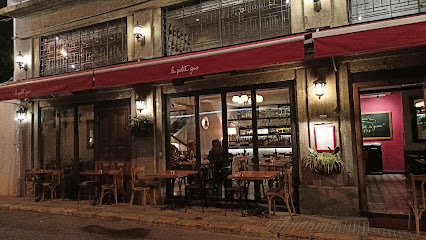
The Met Metropolitan Eatery
0.6 km
Discover the essence of Lebanese cuisine at The Met Metropolitan Eatery in Beirut, where tradition meets modern culinary art.

Cocteau Restaurant
0.6 km
Discover the exquisite flavors of Lebanon at Cocteau Restaurant in Beirut – where tradition meets modern culinary artistry.

Gavi Restaurant
0.6 km
Experience authentic Italian cuisine at Gavi Restaurant in Beirut, where every dish tells a story of tradition and flavor.

The Glow Paradise - Monot
0.6 km
Discover The Glow Paradise in Beirut - where health meets flavor in an inviting atmosphere.
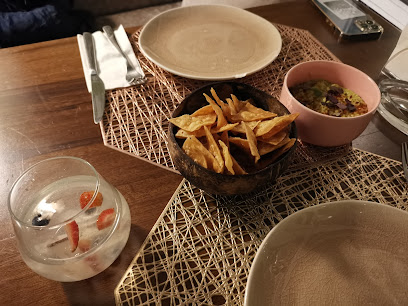
Cupola
0.6 km
Experience authentic Italian cuisine at Cupola in Gouraud, Beirut – where every dish is crafted with passion and tradition.

Plume La Brasserie
0.6 km
Discover the exquisite flavors of French cuisine blended with Italian and Japanese influences at Plume La Brasserie in Beirut.

Dar Beirut
0.7 km
Experience authentic Lebanese cuisine at Dar Beirut in Gemmayzeh—where tradition meets modernity in every delicious bite.

Ritage Garden
0.7 km
Experience exquisite Lebanese cuisine surrounded by lush gardens at Ritage Garden in Beirut - a culinary oasis not to be missed!

Markets, malls and hidden boutiques
Golden Rock Boutique
0.3 km
Explore the stylish Golden Rock Boutique in Beirut for an unforgettable shopping experience filled with contemporary fashion and local charm.

Chouette boutique
0.3 km
Discover unique fashion at Chouette Boutique in Beirut, where contemporary style meets local craftsmanship in a vibrant shopping experience.

ALIA Boutique - Saifi
0.4 km
Shop unique Lebanese fashion at ALIA Boutique in Saifi, Beirut – a perfect blend of local craftsmanship and contemporary style.

Burberry
0.4 km
Discover Burberry in Beirut, where luxury meets fashion in a vibrant shopping experience filled with elegance and style.

Gucci
0.4 km
Explore the luxurious world of Gucci in Beirut, offering exclusive collections of clothing, accessories, and more in a stunning boutique setting.

Longines Boutique - Al Lenbi
0.4 km
Explore the elegance of Swiss watchmaking at Longines Boutique - Al Lenbi, a premier destination in Downtown Beirut for luxury timepieces.

Chic Beirut
0.5 km
Explore Chic Beirut, a vintage clothing haven where unique fashion meets exceptional service in the heart of Lebanon's vibrant capital.

GS Downtown
0.6 km
Explore the chic fashion scene at GS Downtown in Beirut, where modern style meets local craftsmanship in a welcoming atmosphere.

Cookie Dough Boutique
0.6 km
Discover the joy of children's fashion at Cookie Dough Boutique, offering stylish clothing and accessories for your little ones in Beirut.

Izzat
0.7 km
Experience the heart of local culture at Izzat, a unique store showcasing traditional crafts and modern finds – perfect for every traveler.

Vee shop
0.7 km
Explore Vee Shop, a boutique treasure trove offering unique local crafts and personalized service for unforgettable shopping experiences.

Pour Elle Accessories
0.7 km
Explore handcrafted elegance at Pour Elle Accessories, the perfect jewelry store for unique treasures and personalized service.

Sparkles_bath
0.7 km
Explore Sparkles_bath: A Treasure Trove of Unique Souvenirs and Local Artistry Awaiting Your Discovery.

Beirut Art Shop
0.7 km
Discover unique antique treasures at Beirut Art Shop, where history and artistry come together in a stunning collection of furniture and decor.

Nouvelle Vague Vintage Store
0.7 km
Explore the finest vintage clothing and accessories at Nouvelle Vague Vintage Store in Beirut for a unique shopping experience.

Essential bars & hidden hideouts
Capitole By Analogue
0.1 km
Discover the vibrant atmosphere at Capitole By Analogue, a rooftop bar in Downtown Beirut offering stunning views, exquisite cocktails, and a chic ambiance.

Wine يو
0.4 km
Explore the vibrant nightlife of Beirut at Wine يو, a lively pub offering an extensive drink selection and a welcoming atmosphere.
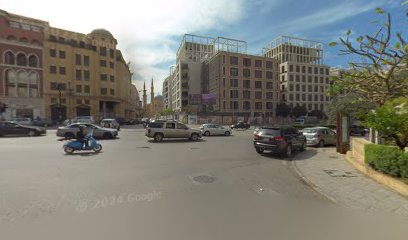
SMALLS
0.5 km
Discover the vibrant nightlife of Beirut at SMALLS, a trendy bar in Gemmayze offering creative cocktails and an eclectic atmosphere.

JIVE
0.6 km
Experience the vibrant nightlife of Beirut at JIVE, where funky cocktails and eclectic vibes create unforgettable memories.

Demo
0.6 km
Experience the lively atmosphere of Gemmayzeh Bar in Beirut, where local flavors and vibrant nightlife come together in perfect harmony.

Miiyao
0.6 km
Discover the vibrant nightlife of Beirut at Miiyao, where signature cocktails and a lively atmosphere await every visitor.

Dragonfly
0.8 km
Discover Dragonfly, a stylish cocktail bar in Beirut's vibrant Gouraud district, known for its innovative drinks and lively atmosphere.

Twenty Two Beirut
0.8 km
Discover the vibrant nightlife of Beirut at Twenty Two Beirut, where local culture meets a lively pub atmosphere for an unforgettable experience.

House of Butlers
1.0 km
Experience Beirut's vibrant nightlife at House of Butlers, where expertly crafted cocktails and a lively atmosphere await every visitor.

Antika
1.1 km
Experience the vibrant nightlife of Beirut at Antika, a premier waterfront bar known for its creative cocktails and stunning Mediterranean views.
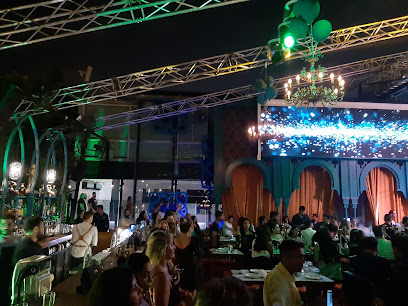
DEAD END PARADISE
1.3 km
Discover the electric ambiance and exquisite cocktails at Dead End Paradise, Beirut's premier cocktail bar for an unforgettable night out.

Flav
1.3 km
Experience the vibrant nightlife of Beirut at Flav, where innovative cocktails and a lively atmosphere create unforgettable moments.

Iris
1.4 km
Experience the vibrant nightlife of Beirut at Iris, where stunning views meet exceptional cocktails in an unforgettable setting.

Tequila
1.4 km
Discover the vibrant nightlife of Beirut at Tequila, where cocktails, music, and good vibes come together for an unforgettable experience.

Sayf - صيف
1.5 km
Experience Beirut's nightlife at Sayf, a chic waterfront lounge offering exquisite drinks, delectable bites, and stunning views.




